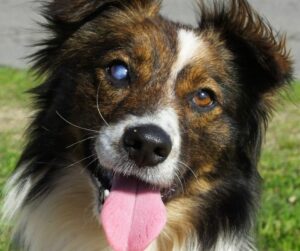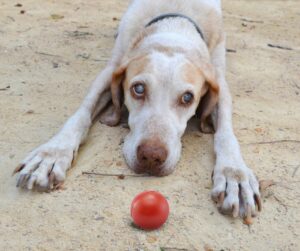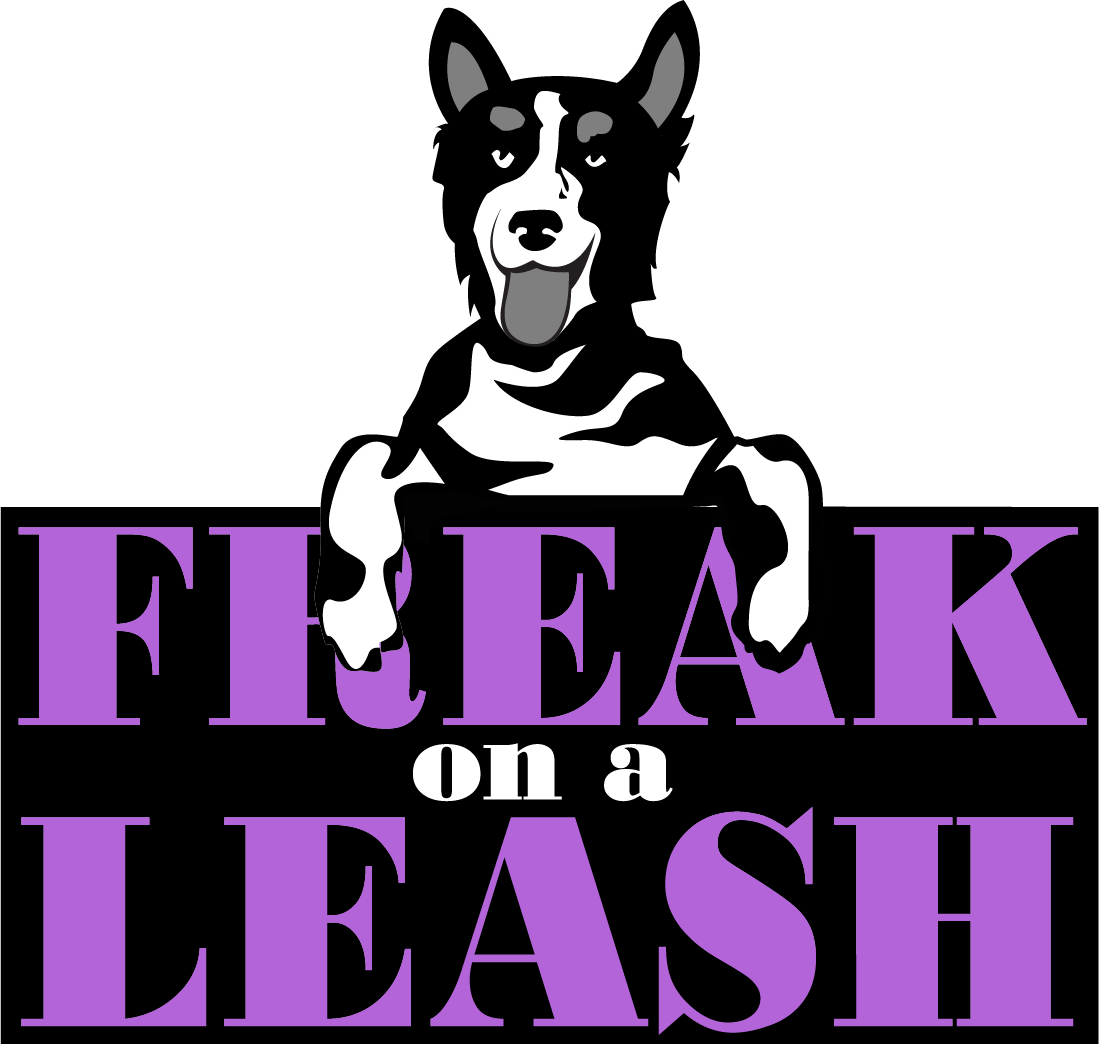The loss of sight is a major challenge for anyone, and the same goes for dogs. Dogs rely heavily on their vision, making vision loss an especially difficult disability with which to cope. The good news is that with your guidance, your pup can still lead a happy and fulfilling life. In this blog, we will take a closer look at how you can help your dog adapt to their surroundings, stay safe, and live happily. We will also debunk some myths about dog behavior that people have when it comes to blindness in dogs. Read on for tips on training techniques, creating a dog-friendly environment, choosing the right toys for your vision-impaired dog, and much more!
Understanding Blindness in Dogs
Blindness in dogs can have various causes, including cataracts or progressive retinal atrophy. Regular check-ups with a vet or ophthalmologist can help monitor your dog’s eyesight and detect any issues early on. Understanding the cause of your dog’s blindness can enable you to provide better care for your dog. It’s important to note that blindness doesn’t mean the end of a happy and fulfilling life for dogs. Blind dogs, with proper care, lead fulfilling lives. When experiencing vision loss, dogs begin relying more heavily on their other senses, such as smell and hearing, to compensate. With extra support and adaptations, your dog can continue to thrive and enjoy their days.
 Debunking Common Misconceptions about Blind Dogs
Debunking Common Misconceptions about Blind Dogs
Myth 1: Blind Dogs are Always Scared
Dogs with vision loss, like sighted dogs, can still take pleasure in playtime and affection. They swiftly adapt to their surroundings, feeling secure with a caring human. Forming strong bonds with their owners, blind dogs have a whole lot of love to give. They are more than capable of experiencing joy, love, and companionship, just like sighted dogs.
Fact 1: How Blind Dogs Adapt to Their Surroundings
Blind dogs utilize their keen sense of smell, hearing, and memory to navigate their surroundings effectively. They can adapt remarkably well by relying on familiar scents and sound cues, allowing them to confidently map out their environment. With proper training, they can respond to verbal or tactile cues from their handler and enjoy outdoor activities with a sighted companion dog or supportive human companion.
Myth 2: Blind Dogs Always Crash into Things
Blind dogs, with their remarkable navigation skills, usually rarely bump into objects. They use their heightened senses to avoid obstacles and navigate their surroundings. They often easily adjust to new environments, and remember familiar layouts. Utilizing a leash, harness, or verbal cues, blind dogs can be taught to expertly avoid collisions. Like sighted dogs, they are able to adapt and move around safely without sight.
Fact 2: The Remarkable Navigation Skills of Blind Dogs
Despite their lack of sight, blind dogs showcase exceptional spatial awareness and navigation skills. They recognize familiar scents, sound markers, and textures to move around effortlessly. By memorizing specific routes and using their acute hearing, they can adeptly avoid obstacles. With training, blind dogs can confidently navigate life through scent trails or cues from a companion dog, showcasing remarkable mobility prowess.
 Differences Between Dogs Born Blind and Those who Become Blind Later
Differences Between Dogs Born Blind and Those who Become Blind Later
Dogs born blind often have better developed senses compared to those who become blind later in life. Since they have never experienced vision, their other senses such as hearing and smell are often heightened. On the other hand, dogs that experience vision loss later may require more time to adjust to their new circumstances. Blindness that occurs later in life can be caused by various factors like injury or disease. The way blind dogs adapt to their condition can vary depending on whether they were born blind or became blind later. Whichever the case though, they can still lead fulfilling lives with proper care and support.
Providing for a Blind Dog’s Needs
Establishing a consistent routine is essential when providing for a blind dog’s needs. Consistency will help them feel more secure in their environment and provides a sense of familiarity. Clear verbal cues and tactile signals are effective ways of communicating with a blind dog, as they rely heavily on their other senses. Creating a safe and familiar environment is critical to help blind dogs navigate their surroundings with ease. Utilizing scent work and other mental stimulation activities can help keep them engaged and entertained. Understanding a blind dog’s unique needs allows for the adaptation of care and training approaches, and will ensure their well-being and happiness.
Keeping Your Blind Dog Safe: What’s Different?
Securing your home with baby gates and eliminating hazards can ensure your blind dog’s safety. Use scent markers or textures on furniture and stairs for tactile guidance. Keep a consistent layout and minimize changes to the environment. Supervise outdoor activities, use leashes or harnesses, and provide auditory cues to help your blind dog stay aware. If your pup runs into a lot of things after becoming blind, a halo may be a good investment to avoid injuries.
Training Techniques for Blind Dogs
Establishing a consistent routine and using positive reinforcement are effective training methods for blind dogs. Incorporating touch and scent cues into training helps them understand commands, as well as breaking down tasks into smaller steps. Interactive toys and treat puzzles provide mental stimulation and rewards during training sessions. As with sighted dogs, patience and consistency are key when training blind dogs, allowing them to learn at their own pace. It is important to tailor the training approach to each individual’s needs and abilities. By following these techniques, blind dogs can develop the necessary skills to learn new things with confidence.
The Importance of Routine and Consistency
Establishing a consistent routine provides structure and familiarity, which can help your blind dog navigate their environment more easily. Following a regular feeding and exercise schedule is particularly important, as it helps dogs feel secure and confident. Consistent training sessions and reinforcement of cues are also key in building trust and reinforcing good behavior. By maintaining a consistent daily routine, blind dogs are less likely to experience anxiety or insecurity. Overall, routine and consistency play a vital role in the well-being and confidence of blind dogs.
Introduction of New Cues for Safety
When training dogs with vision loss, it is important to introduce new cues gradually and use positive reinforcement. Building on existing cues and associations can make it easier for them to grasp new concepts. In addition to verbal cues, the use of tactile cues and scent signals can aid blind dogs in learning new behaviors. Patience and repetition are key when introducing new cues to ensure the dog fully understands and retains the information. Creating a safe and supportive environment during training sessions can greatly increase the success rate. By implementing these techniques and providing a consistent and encouraging atmosphere, blind dogs can learn and adapt to new cues.
Creating a Dog-Friendly Environment for a Blind Dog
Creating a safe and comfortable environment is vitally important for dog;s with vision loss. Placing rugs or mats with different textures throughout the house can assist them in navigating various areas. Secure baby gates or barriers should be used to prevent access to potentially hazardous spaces. Adding corner protectors to furniture and other sharp edges can help minimizes the risk of injury. Scent markers or scented toys can help blind dogs identify specific areas or objects. It’s also essential to provide a designated safe zone with comfortable bedding and familiar scents to offer a sense of security. By implementing these measures, you can help your blind dog feel more confident and navigate their surroundings with ease.
How to Dog-Proof Your Home
Keeping your blind dog safe at home involves taking certain precautions to dog-proof your living space. One important step is to ensure that potentially toxic substances are kept out of reach, reducing any risk of accidental ingestion. Securing any loose cords or wires can prevent your blind dog from getting tangled or injured. It is also crucial to remove any small objects or choking hazards that might pose a danger to your furry friend. In addition, make sure there are no sharp or protruding objects in your dog’s environment that could cause injury. Regularly inspecting your home for potential hazards and addressing them promptly will help create a safe and comfortable environment for your blind dog.
Using Sounds and Scents as Cues
Incorporating a variety of sensory cues is essential when training a blind dog. Verbal cues and other sound signals are effective communication tools, allowing you to guide your pup without relying on visual cues. Additionally, using different scents can help your blind dog navigate and identify objects in their environment. Ambient noise can play a crucial role in providing a sense of direction and orientation for your dog, and training your dog to recognize specific sounds like a squeak or a doorbell can further enhance their ability to learn new skills and navigate their surroundings. Moreover, utilizing a dog’s keen sense of smell by placing a distinctive scent on objects can guide them effectively. By incorporating these cues, you can create a stimulating and supportive environment for your blind dog’s life and training journey.
 Toys and Activities for Blind Dogs
Toys and Activities for Blind Dogs
Providing safe and interactive toys for blind dogs can stimulate their remaining senses and keep them engaged. Toys that make noise or have different textures can be especially beneficial. Additionally, engaging in scent work activities with your blind dog not only keeps them mentally stimulated but also provides a sense of accomplishment. Introducing new cues and tricks can challenge and engage your blind dog, helping them learn and adapt. Incorporating active play into their daily routine promotes exercise and bonding. When creating a play area for your blind dog, be sure to to remove any sharp-edged furniture or use corner protectors to ensure their safety.
Choosing the Right Toys: The Role of Noise
When choosing toys for your blind dog, consider their senses of hearing, smell and touch. Toys that make noise, such as squeaky toys or toys with specific scents, can help your blind dog locate and interact with them. Additionally, look for toys that provide different textures and tactile experiences, as these can enhance your blind dog’s playtime. As with any dog, remember to prioritize safety by opting for toys that are durable and free from small parts that could be a choking hazard. It is also a good idea to rotate and introduce new toys regularly to keep your dog engaged and prevent boredom. By selecting the right toys, you can provide your blind dog with enjoyable and stimulating play experiences.
Can a Blind Dog Live a Full Life?
Blind dogs can lead very fulfilling lives with proper care and support. They rely on their other senses to navigate and adapt to their surroundings. Providing a safe environment, regular vet check-ups, and seeking guidance from professionals as needed can help them live happy lives.
Conclusion
Blindness does not have to be a barrier to a fulfilling life for your dog. With the right skills, training, and environment, dogs with vision loss can adapt and thrive just like any other dog. It is important to debunk myths and misconceptions about their behavior, and to understand the differences between dogs born blind and those who lose their vision later in life. By providing a safe and dog-friendly environment, incorporating routine and consistency in training, and using sounds and scents as cues, you can help your blind dog navigate their world with safety and confidence. Remember, a blind dog can still enjoy toys and activities, so choose toys that stimulate their senses and provide opportunities for play. With love, patience, and proper care, a blind dog can lead a happy and fulfilling life. If you need help training your blind dog, we are here for you!

